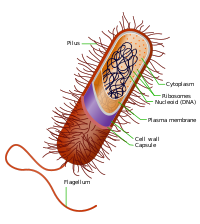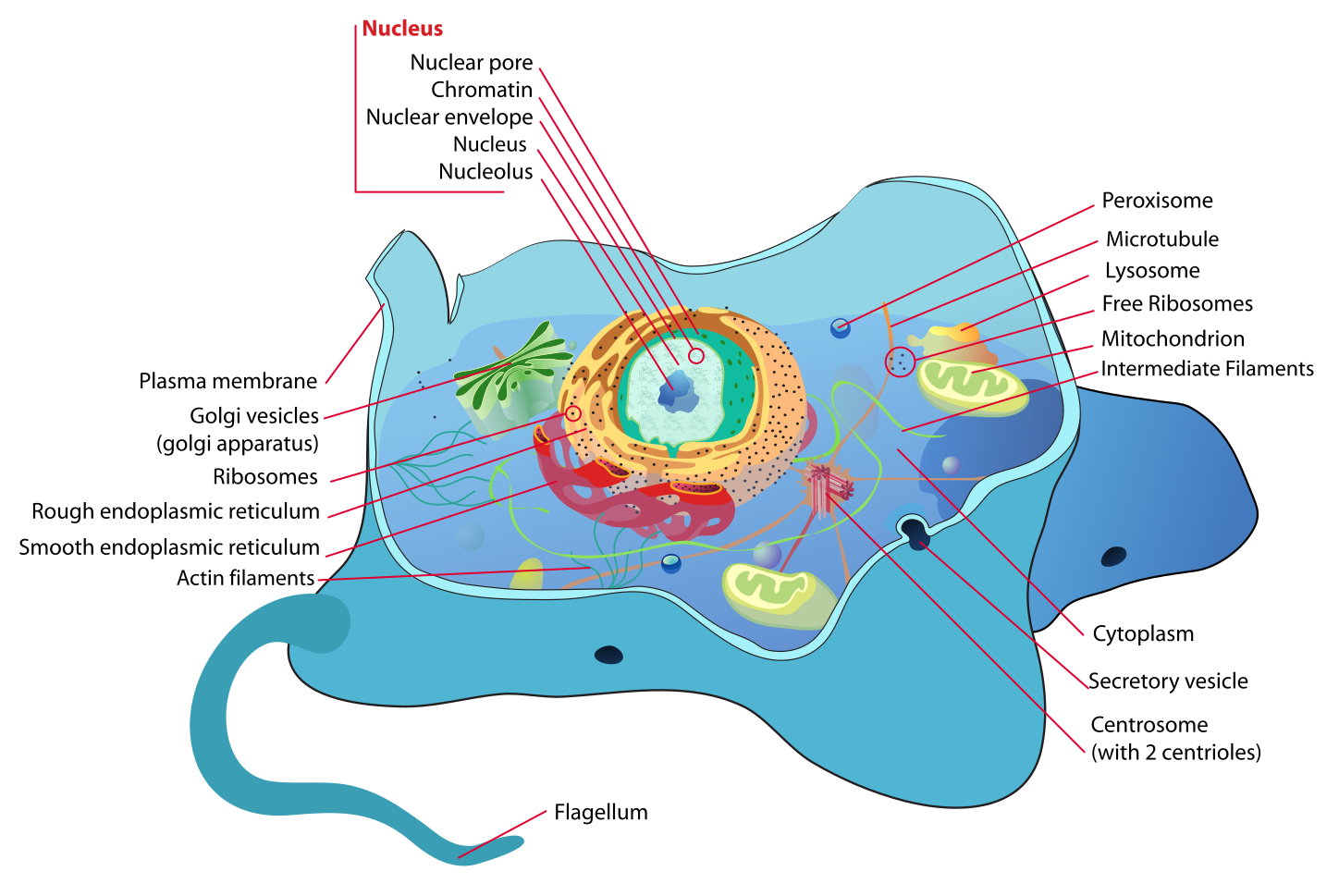
Natural Science - Year I
Unit 25: Cell Components and Structures

Science Weblecture for Unit 25
| This Unit's | Homework Page | History Lecture | Science Lecture | Lab | Parents' Notes |
Science Lecture for Unit 25: The Cell
For Class
- Topic area: Microbiology
- Terms and concepts to know: Cells, chromatin, organelles, nucleus, endoplasmic reticulum, Golgi bodies, bacteria, viruses, eukaryotic and prokaryotic cells
- See historical period(s): Robert Boyle and the Microscope
Lecture Outline
Cells as the Fundamental Units of Life
The microscopic observations of the 17th century led to one of the basic tenets of modern biology: all life is based on cellular organization. Further observation of cell life led to a second basic principle: all cells come from existing cells.
All life forms known have one or more cells; while in multicellular organisms, individual cells are specialized and may not survive on their own, in single-celled organisms, such as the protists and bacteria that van Leeuwenhoek observed, the cell contains all the materials and performs all the functions required by a living entity.
Most cells share similar characteristics, but there are major differences between bacteria and protists, and between plant and animal cells. All cells have some kind of membrane or cell wall which keeps the cell contents inside, and which provides a barrier against undesirable chemicals or organism while allowing selected chemicals, such as nutrients, to enter the cell. Inside the cell are several different kinds of self-contained structures.
Cell Components
Some structures provide for the manufacture of cell parts or the protein components needed for them.
- The nucleus contains chromatin, the long strands of a chemical call deoxyribose nucleic acid (DNA), which contain the chemical instructions for all functions performed by the cells.
- Endoplasmic rheticulum is a membrane-like structure studded with ribosomes; protein manufacture takes place in the ribosomes.
- Golgi bodies package the protein strands, combining them if necessary, and pass them to the appropriate area of the cell for use.
- Lysosomes contain enzymes (chemicals) which break down the components of worn-out organelles or used-up proteins, and make the basic chemical components available fore reuse.
Several organelles provide for energy storage and release in the cell.
- In some bacteria, some protists, and all plants, chloroplasts contain chemicals which absorb light energy and convert it into chemical energy in the form of fats and sugars.
- In all eukaryotic (see below) cells, mitochondria break down sugars and release energy for use in protein manufacture and cell growth
The shape of the overall cell is maintained by a lattice of microtubules.
Prokaryotes: Bacteria and Archaea

Bacteria and Archaea cells (prokaryotic cells) differ from eukaryotic cells (everything else) in several ways.
- Prokaryotes have no nucleus; their DNA material floats in the cytoplasm.
- The membranes of prokaryotes contain special proteins not found in other cells.
- Prokaryotes have no organelles, and so are much simpler than eukaryotic cells.
- Prokaryotes normally reproduce by binary fission, in which the cell doubles its DNA, then breaks evenly in half, so that each daughter cell is a clone of the parent.
- Prokaryotes can exchange some of the DNA, which results in new cells with genes that differ from the parent
Eukaryotes: Protists (single-celled)
Eukaryotic cells are much more complicated than bacteria cells. Even single-celled eukaryotes, —protists like the amoeba and paramecium—have specialized structures for ingesting, metabolizing, and reproducing.- Eukaryotic membranes contain many types of "gates" which precisely control the amount of different chemicals inside the cell.
- The DNA of a eukaryotic cell is contained inside the nucleus, which has its own membrane.
Plant and animal cells, both types of eukaryotic cells, also differ from each other in several ways. Some structures are found only in plant cells:
- Plant cell walls have cellulose, a type of starch which provides strength and rigidity.
- Plant vacuoles are large and contain amounts of water which the plant regulates.
- Plants have chloroplasts, which enable them to create their own food.
Animal cells have lysosomes contain enzymes (chemicals) which break down the components of worn-out organelles or used-up proteins, and make the basic chemical components available fore reuse.

By the way, viruses, which are small entities that are capable of rapid reproduction and production of chemicals, are not considered truly living organisms. Viruses do not have cell membranes, nuclei, or organelles. They cannot reproduce without taking over the DNA of the host cell. Nevertheless, viruses have a serious impact on life on earth, causing many diseases, such as the common cold, polio, smallpox, and AIDS.
Use the Cell Functions table at the Biology Junction site to identify which types of cells have each component, what the component is like (description), and what function it plays in the organism.
Use information from both sites to answer the questions below.
- What are the basic chemical components of the cell? Which is present in he largest amount?
- Which components found in a plant cell are not found in animal cells?
- Which components found in animal cells are not found in plant cells?
- What is the function of the following cell structural components (organelles)?
- Nucleus
- Chromosome
- Mitochondrion
- Chloroplast
- Endoplasmic Rheticulum
- Why are most cells small?
- What are the differences between prokaryotes (bacteria) and eukaryotes (everything else)?
Study/Discussion Questions:
- Scientists use organization of biological material into a cell structure as one of the key characteristics of life. How does this criteria limit what we can call "living"? Is this kind of criteria necessary?
- Key differences in cells structure are now used to divide living organisms into "domains", extending our categories of living things. What other criteria could be used to categorize living beings? What is the advantage of emphasizing a particular characteristic (such as cell structure) over appearance (such as having fur)?
Further Study/On Your Own
- Explore cells of all types at Cells Alive!.
© 2005 - 2025 This course is offered through Scholars Online, a non-profit organization supporting classical Christian education through online courses. Permission to copy course content (lessons and labs) for personal study is granted to students currently or formerly enrolled in the course through Scholars Online. Reproduction for any other purpose, without the express written consent of the author, is prohibited.